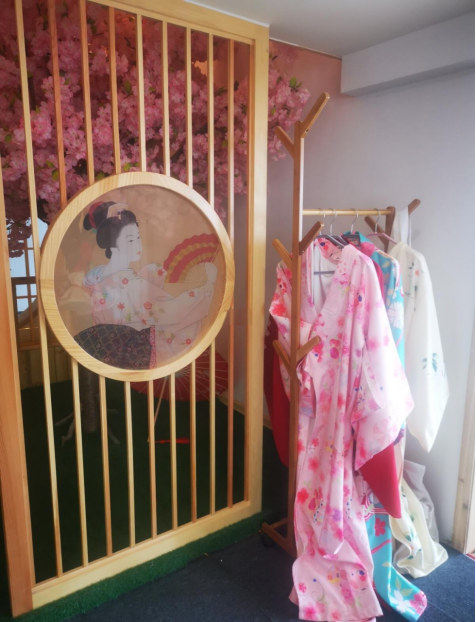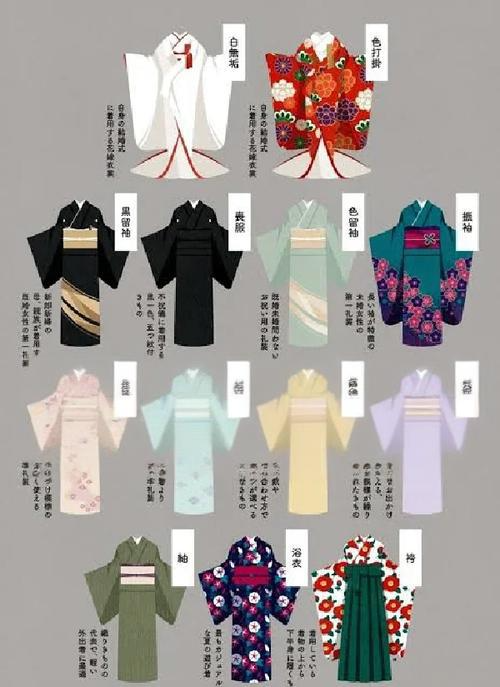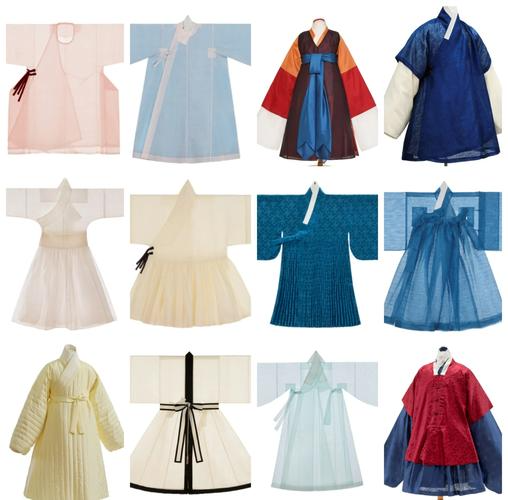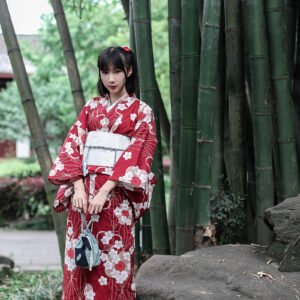Kimono is Japan’s traditional national costume. Its design is deeply rooted in natural aesthetics and practical philosophy. Kimono’s structure carries strong national sentiment and spiritual expression. It adopts straight-line cutting, presenting an overall T-shape with almost no curved elements.Key signature features of kimono include crossed collars with the right side over the left, wide sleeves, and a length that covers the ankles.Kimono fabrics are mostly silk, cotton, or linen, and emphasis is placed on seasonal matching.Kimono patterns often draw inspiration from nature-such as cherry blossoms, vines, flowing water, and flowers. These patterns are delicately created through Japan’s unique dyeing techniques like yuzen-zome (hand-painted resist dyeing) or katazome (stencil dyeing).

Hanfu VS Kimono
Historically, Hanfu (traditional Chinese costume) influenced and aided the formation and development of kimono.The basic structural features of Hanfu were introduced to Japan during the Tang Dynasty.After localized adaptation in Japan, these features evolved into kimono-a traditional costume with distinct Japanese ethnic styles.

Key Features of Japanese Kimono
The typical styles of kimono are strictly differentiated by gender, age, and occasion.
For women: The main styles include furisode (long-sleeved formal wear for unmarried women), tomosode (short-sleeved formal wear for married women), and homongi (formal wear for official visits).
For men: The typical style usually consists of haori (an outer robe) paired with hakama (pleated skirt-like trousers).
The most meaningful and ceremonial kimono style is shiromuku—a pure white wedding dress symbolizing purity, commonly worn in Japanese weddings.
When compared with Hanbok (traditional Korean costume): Hanbok emphasizes color contrast and curves, while kimono focuses on flat decoration and straight-line outlines.Additionally, the 9-piece set of kimono is not only aesthetically significant but also practical. For example, the “adjustment belt” can adjust tightness, and zori (sandals) and tabi (split-toe socks) match traditional ways of walking.

Japanese Kimono Making Process
The production of kimono emphasizes exquisite craftsmanship.It goes through dozens of procedures, from weaving and dyeing to overall sewing.Some high-end kimono styles use nishijin-ori (brocade from Nishijin, Kyoto) or kasuri (tie-dyed weaving) techniques, with patterns crafted delicately to pursue fine details.Yuzen-zome, a typical kimono dyeing technique, is famous for its hand-painted paste resist-dyeing method. This technique outlines delicate flower and bird patterns.The exquisite craftsmanship of kimono means that…

How to Maintain and Clean Japanese Kimono
Maintaining kimono is also crucial.Kimono cannot be machine-washed. It usually needs to be disassembled for dry cleaning or spot cleaning.For storage, kimono should be placed flat in a dark area to prevent creases and fading.

Chinese People’s Views on Kimono
From kimono’s historical evolution, we can see it has an inherited relationship with Hanfu and shows obvious kinship.Derived from Hanfu, kimono is quite popular in contemporary China—but only commonly seen in limited occasions, such as cultural exchange events and anime exhibitions.Chinese people generally hold a rational attitude toward kimono: they recognize its artistic value while maintaining a clear cultural boundary between China and Japan.Chinese people usually wear kimono only in specific scenarios; it is very rare in daily dressing.There is no specific Chinese name or “Chinese version” for kimono in China.Kimono is essentially very different from China’s local traditional costumes. The so-called “traditional Chinese kimono” does not exist at all.Kimono originated from China but never developed or existed in China. Similarly, the term “Chinese kimono skirt” is also inaccurate.The confusion of these terms reflects a common misunderstanding in cultural exchanges.
In recent years, Japan has stepped up its cultural promotion efforts. It frequently holds cultural publicity activities to bring kimono to the global stage and build Japan’s international image.The inheritance and development of kimono in Japan also maintain a rapid momentum, with its cultural heritage value further strengthened.The presence of kimono is gradually increasing in large-scale events, celebrations, cultural programs, and on stage.

Here, I need to correct a misunderstanding: some people refer to traditional Korean costumes as “Korean kimono,” which is incorrect.Traditional Korean costumes are called Hanbok. Their common names include: chima (skirt), jeogori (jacket), dangui (formal jacket), juui (overcoat), danryeong (long robe), dae (scholarly robe), gujangbok (nine-patterned robe), gunryongpo (dragon robe), and jeui (royal female robe).






 Buy Red Japanese Kimono & Yukata For Cheap
Buy Red Japanese Kimono & Yukata For Cheap